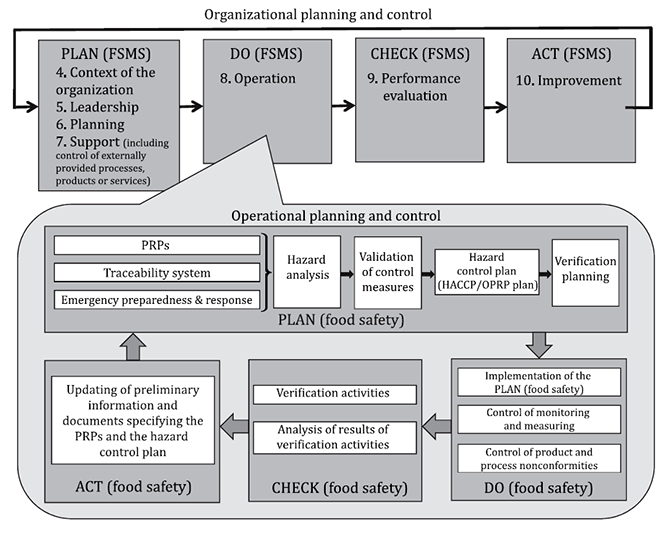|
в–·ISO 22003-1:2022 Summary of Changes
- New HACCP Study definition
- Changes/additions to Clause 7:
- Changes/additions to Clause 8:
- Changes/additions to Clause 9:
- Changes/additions to Annex A: Changes to subcategories and clusters
- Changes/additions to Annex B: Adjustment to the minimum onsite audit days
- Changes/additions to Annex C: Changes in competencies
Key time schedule
ISO22003-1:2022 was issued in June 2022, and as accordint to the IAF decision, the schedule below is based on 30 June 2022.
| Activity |
Due date / Description |
Timeline |
| CAB may use ISO22003-1:2022 for all initial clients after accreditation for ISO22003-1:2022 |
Date to be determined for each CB based on transition date, but no later than |
24months from publication month of document- 30 June 2024 or transition of the accreditation, whichever is later. |
| CAB to use ISO22003-1:2022 for all clients no later than |
30 months from publication month of document |
From 2025.1.1 |
| **CABs to implement all changes impacting their existing clients such as sampling and audit time calculations no later than |
36 months from publication month of document |
2025.6.30 |
в–·ISO22000:2018
Food safety management systems вҖ” Requirements for any organization in the food chain
1. FSMS principles
Food safety is related to the presence of food safety hazards at the time of consumption (intake by the consumer). Food safety hazards can occur at any stage of the food chain. Therefore, adequate control throughout the food chain is essential. Food safety is ensured through the combined efforts of all the parties in the food chain. This document specifies the requirements for a FSMS that combines the following generally recognized key elements:
- interactive communication;
- system management;
- prerequisite programmes;
- hazard analysis and critical control point (HACCP) principles.
In addition, this document is based on the principles that are common to ISO management system standards. The management principles are:
- customer focus;
- leadership;
- engagement of people;
- process approach;
- improvement;
- evidence-based decision making;
- relationship management
2. Process approach
2.1 General
This document adopts a process approach when developing and implementing a FSMS and improving its effectiveness to enhance production of safe products and services while meeting applicable requirements. Understanding and managing interrelated processes as a system contributes to the organizationвҖҷs effectiveness and efficiency in achieving its intended results. The process approach involves the systematic definition and management of processes, and their interactions, so as to achieve the intended results in accordance with the food safety policy and strategic direction of the organization. Management of the processes and the system as a whole can be achieved using the PDCA cycle, with an overall focus on risk-based thinking aimed at taking advantage of opportunities and preventing undesirable results.
The recognition of the organizationвҖҷs role and position within the food chain is essential to ensure effective interactive communication throughout the food chain.
2.2 Plan-Do-Check-Act cycle
The PDCA cycle can be described briefly as follows:
| Plan |
establish the objectives of the system and its processes, provide the resources needed to deliver the results, and identify and address risks and opportunities; |
| Do |
implement what was planned; |
| Check |
monitor and (where relevant) measure processes and the resulting products and services, analyse and evaluate information and data from monitoring, measuring and verification activities, and report the results; |
| Act |
take actions to improve performance, as necessary. |

Illustration of the Plan-Do-Check-Act cycle at the two levels
3 Risk-based thinking
3.1 General
Risk-based thinking is essential for achieving an effective FSMS. In this document, risk-based thinking is addressed on two levels, organizational (see 0.3.3.2) and operational (see 0.3.3.3), which is consistent with the process approach described in 0.3.2.
3.2 Organizational risk management
Risk is the effect of uncertainty, and any such uncertainty can have positive or negative effects. In the context of organizational risk management, a positive deviation arising from a risk can provide an opportunity, but not all positive effects of risk result in opportunities.
To conform to the requirements of this document, an organization plans and implements actions to address organizational risks (Clause 6). Addressing risks establishes a basis for increasing the effectiveness of the FSMS, achieving improved results and preventing negative effects.
3.3 Hazard analysis вҖ” Operational processes
The concept of risk-based thinking based on the HACCP principles at the operational level is implicit in this document.
reduce hazards to acceptable levels to ensure food is safe at the time of consumption (Clause 8).
Decisions taken in the application of HACCP should be based on science, free from bias and documented. The documentation should include any key assumptions in the decision-making process.
0.4 Relationship with other management system standards
This document has been developed within the ISO high level structure (HLS). The objective of the HLS is to improve alignment between ISO management system standards. This document enables an organization to use the process approach, coupled with the PDCA cycle and risk-based thinking, to align or integrate its FSMS approach with the requirements of other management systems and supporting standards.
This document is the core principle and framework for FSMSs and sets out the specific FSMS requirements for organizations throughout the food chain. Other guidance related to food safety, specifications and/or requirements specific to food sectors can be used together with this framework.
In addition, ISO has developed a family of associated documents. These include documents for:
- prerequisite programmes (ISO/TS 22002 series) for specific sectors of the food chain;
- requirements for auditing and certification bodies;
- traceability.
ISO also provides guidance documents for organizations on how to implement this document and related standards. Information is available on the ISO website.
|